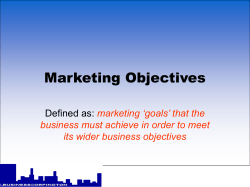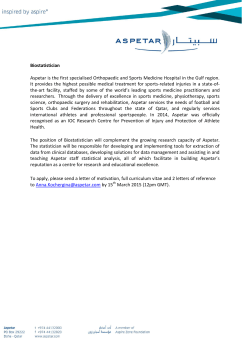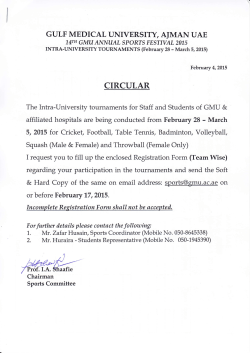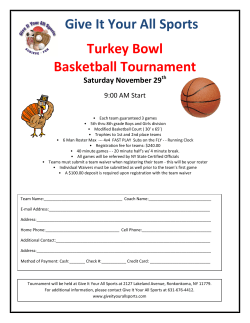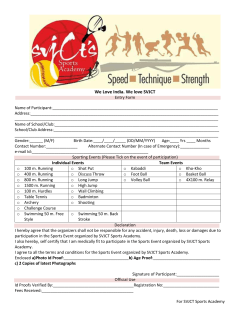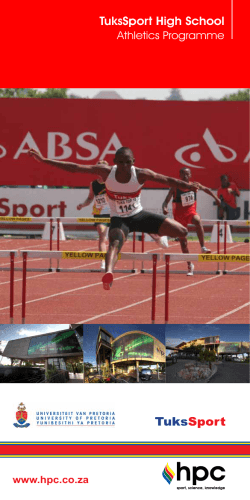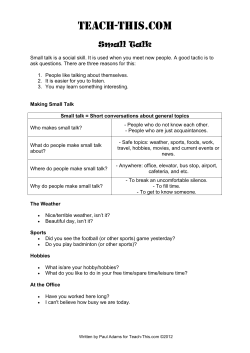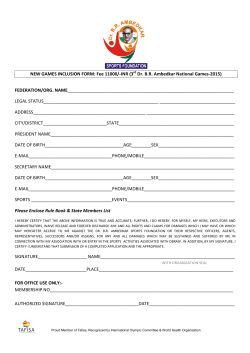
Summon The Magic Bibliography with notes The Achievement Zone
Summon The Magic Bibliography with notes
The Achievement Zone, Shane Murphy, Ph.D., GP. Putnam's Sons, New York 1996.
[Written by the chief sport psychologist for the US Olympic Committee from ’87 to ’94.]
Afterwards, You’re a Genius: Faith, Medicine and the Metaphysics of Healing, Chip
Brown, Riverhead Books (Penguin Putnam), New York 1998. [A journalist, a skeptic by
profession who, if he did not become a True Believer, at least came to understand that it
starts with belief.] The Age of Spiritual Machines: When Computers Exceed Human Intelligence, Ray
Kurzweil, Penguin Audiobooks, New York, 1998. [Written by the man who invented the
Kurzweil music synthesizer and a machine that can read out loud any text placed on its
scanner, the brains behind advanced speech recognition and the author of the earlier Age
of Intelligent Machines, this book forecasts a world in less than two decades in which the
difference between man and machine is blurred, the line between technology and
humanity has faded, a time when machines will be capable of teaching and replicating
themselves.] Aikido and the New Warrior, ed. by Richard Strozzi Heckler, North Atlantic Books,
Berkeley, CA 1985. [An outstanding book on the ways in which a mind/body/spirit
discipline can be dramatically applied to everyday life, in athletics, and in working with
youth. The author is a former Olympic-caliber athlete with a PhD. in psychology who has
done pioneering work with troubled adolescents, corporations, Olympic athletes, Green
Berets and Navy SEALS.] Aikido and the Dynamic Sphere: An Illustrated Introduction, A. Westbrook and 0. Ratti,
Chas. E. Tuttle Co., Boston, 1970. [A great book if you are going to take up the way of
harmony of spirit.] The Anatomy of Change: East/West Approaches to Body/Mind Therapy,
Richard Strozzi Heckler, Shambhala Publications, Boulder, Colorado, 1984.
The Art of Peace, Morihei Ueshiba, Shambhala Classics, Boston 2002. [Translated and
edited by John Stevens, this is the work of a master of ki, and the founder of aikido, the
most enlightened and spiritual of the martial arts.]
The Art of Possibility, Rosamund Stone Zander and Benjamin Zander, Harvard Business
School Press, 2000. [A delicious little book for leaders that invites you to open the door
to the full potential of what's happening around you.]
The Art of Team Coaching, Jim Hinkson, Warwick Publishing, Toronto, 2001.
[An NHL coach calls it the ultimate "how-to-coach" book.] The Art of War, Sun Tzu. [Written by a Chinese military strategist about 2,500 years ago,
the wisdom and insight in this book has stood the test of time. I am aware of at least
seven translations; for beginners, I recommend James Clavell's version.]
The Artist's Way, Julia Cameron with Mark Bryan, Jeremy Tarcher/G. P. Putnam Books,
New York, 1992. [A path for uncovering or unblocking your innate creativity. In my case,
it prompted me to begin this compilation.]
Awakening to the Sacred: Creating a Spiritual Life from Scratch, Lama Surya Das,
Broadway Books, Random House, New York. 1999.
Baseball's Greatest Quotations, Paul Dickson, Harper/Perennial. New York, 1991. [If you
love the game, you'll love the book.]
Becoming Adult: How Teenagers Prepare for the World of Work, Mihaly
Csikszentmthalyi and Barbara Schnieder, Basic Books, New York, 2000.
Better, Atul Gawande, Henry Holt, Metropolitan, 2007. [Notable for a discussion about
due diligence en route to positive deviance.]
Beyond Training: How Athletes Enhance Performance Legally and Illegally,
Melvin Williams, Ph.D., Leisure Press, Champaign, IL 1989. Blink: The Power of Thinking Without Thinking, Malcolm Gladwell, Little, Brown &
Co., Boston, 2005. [By the author of The Tipping Point, an outstanding and highlyreadable look at instantaneous judgment.]
Body Mind Mastery: Creating Success in Sport and Life, Dan Millman, New World
Library, Novato, California, 1999. [Millman is a former world champion on the
trampoline, a Hall of Fame gymnast, a coach and a university professor. This is a revision
of his earlier book The Inner Athlete.]
Boyd: The Fighter Pilot Who Changed The Art of War, Robert Coram, Little, Brown and
Co., Boston, 2002. [A biography of the USAF fighter pilot who: defined, refined,
codified and taught effective aerial combat tactics; whose techniques as an instructor
preceded and predicated the famous Navy "Top Gun" school; who as an engineer
developed a formula on energy and maneuverability that explained and proved his theory
on air-to-air combat tactics and drove the design of the F-15 and other advanced military
fighters; who as a Pentagon analyst changed the way the military designs and procures
weaponry; who as a strategic thinker developed the OODA loop theory that reformed
military strategy and other forms of competition; whose work informed such diverse
books as Thriving on Chaos by Tom Peters and The Mind of War by Grant Hammonds;
whose work as an intellectual codified and redefined creativity; and whose efficacy as a
mentor allowed many acolytes to continue to expand on his powerful contributions within
the highest echelons of government, the military, business and community leadership.]
Breakfast at the Victory: The Mysticism of Ordinary Experience, James P.. Carse,
HarperOne, San Franciso, 1994. [A delightful read by a retired professor of the history of
literature and religion.]
Breaking the Habit of Being Yourself: How To Lose Ypur Mind and Create a New One,
Dr. Joe Dispenza. Hay House Inc. 2012. [Advanced material from an advanced educator,
the second of three books and countless other materials.]
The Break-Out Principle, Herbert Benson, M.D. and William Proctor, Scribner, New
York 2003. [How to activate your accessible biomechanical “trigger” to power up
creativity, insight, stress-reduction, and top-notch performance, by the author of The
Relaxation Response.]
The Breakthrough Factor, Henry Marsh, Simon & Schuster, 1997. [Marsh is a former
Olympic steeplechase runner, now a corporate consultant.]
The Bridge of Stars: 365 Prayers, Blessings and Meditations from Around the World,
Marcus Braybrooke (editor), Duncan Baird Publishers, London, 2001.
Changing Minds (The Art and Science of Changing Our Own and Other People’s Minds),
Howard Gardner, Harvard Business School Press 2006. Coaches Guide to Sport Psychology, Rainer Martens, Ph.D., Human Kinetics,
Champaign, IL, 1997. [A high-level academic textbook for coaches.]
The Coaches' Little Playbook: Thoughts from Great Coaches About the Greatest Game of
All -- Life, George Hetzel, Jr., Cumberland House Publishing, Nashville, TN 1996.
[Another source of quotes.]
Coaching Mental Excellence: It Does Matter Whether You Win Or Lose, Ralph
Vernacchia, Rick McGuire, and David Cook, Warde Publishers, Portola Valley, CA 1996.
[Written for coaches by three of the nation's top coaching educators, performance
consultants, and sports psychologists, this book is an outgrowth of a top-level national
meeting to develop an applied sports psychology curriculum for a national coaching
education program.]
Coaching Fastpitch Softball Successfully, Kathy Veroni, Human Kinetics, 1998.
Coaching for Performance: A Practical Guide to Growing Your Own Skills, John
Whitmore, Pfeiffer and Company, 1994. [The author is the co-founder of The Inner Game
Ltd., one company among many that have taken the lessons from winning athletes into
the world of business.]
Coaching The Mental Game: Leadership Philosophies and Strategies for Peak
Performance in Sports – And Everyday Life, Harvey A. Dorfman, Taylor Trade
Publishing (Rowman & Littlefield), New York 2003. [See his series on “The Mental
Game…”, "The Mental Keys…” and “The Mental ABC’s… ” noted below.]
Communications in the 21st Century, ed. by Robert Haigh, George Gerbner and Richard
Byrne, John Wiley and Sons, NY, 1981. [Based on a symposium sponsored by the
Colgate Darden School of Business Administration at the University of Virginia, and the
Annenberg Schools of Communication at the Universities of Southern California and
Pennsylvania.]
Confidence: How Winning Streaks and Losing Streaks Begin and End, Rosabeth Moss
Kanter, Random House/Crown Business, NY, 2004. [Kanter is a leading authority on
leadership, innovation, transformation and change. Highly recommended for coaches…!] Competitive Fire: Insights into developing the warrior mentality of sports champions,
Michael Clarkson, Human Kinetics, 1999.
Composing a Life, Mary Catherine Bateson, Plume, 1990. [Life as a work in progress the improvisations of five extraordinary women.]
Counter Clockwise: mindful health and the power of possibility, Ellen Langer, Ballantine
Books, NY 2009.
Create Your Own Future: How To Master the 12 Critical Factors of Unlimited Success,
Brian Tracy, John Wiley & Sons, Hoboken, NJ 2002.
Creative Visualization: How To Use Imagery and Imagination for Self-Improvement,
Ronald Shone, Destiny Books, Rochester, Vermont, 1988.
Creativity: Where the Divine and the Human Meet, Matthew Fox, Tarcher/Putnam, New
York 2002.
Deep Play, Diane Ackerman, Random House, New York, 1999.
Deep Survival: Who Lives, Who Dies, and Why, Laurence Gonzalez, W.B. Norton and
Co., NY, 2003. [The skills and mind-sets useful when you find yourself on the peripheries
of life are remarkably similar to those useful in any stressful, demanding situation.]
The Denial of Death, Ernest Becker, Free Press, 1973. [This stunning Pulitzer Prize
winning book by a cultural anthropologist, on man’s refusal to acknowledge his own
mortality, was given to me to read by a close and dear friend after I was discharged from
the hospital.] Discover Your Genius: How To Think Like History's Ten Most Revolutionary Minds,
Michael J. Gelb, HarperCollins, NY 2002.
Education and Ecstasy, George B. Leonard, Delacorte Press, New York 1968.
The Elements of Effort: Reflections on the Art and Science of Running, John Jerome,
Broadway Books, New York, 1997. [On stretching, breathing, eating, training, racing,
biochemistry, ligaments, physics, psychology, neurology and sweat.] The Elements of Mentoring, W. Brad Johnson and Charles B. Ridley, Palgrave
Macmillan, NY 2004. Emergence: The Connected Lives, of Ants, Brains, Cities and Software, Steven Johnson,
Touchstone Books, 2002. [On the evolution of organizations.]
The Emerging Mind, ed. by Karen Nesbitt Shanor, PhD, Renaissance Books, Los
Angeles, CA 1999. [Based on the Smithsonian Institution lecture series on new research
into consciousness.]
Embracing Fear, Thom Rutledge, HarperSanFrancisco 2002.
Embrace Tiger, Return to Mountain: The Essence of Tai Ji, Chungliang Al Huang,
Celestial Arts, Berkeley, CA 1987.
Embracing Your Potential, Terry Orlick, PhD., Human Kinetics, Champaign, IL, 1998. [A
former gymnast and coach, the author is one of the best in the field of mental training for
excellence and has worked with thousands of Canadian and American Olympic and
professional teams and athletes.]
Emotional Alchemy: How The Mind Can Heal the Heart, Tara Bennett-Goleman,
Harmony Books, NY 2001. [Written by a psychotherapist, the wife of the author of the
book Emotional Intelligence, on schema therapy and mindfulness.]
Endurance Techniques, Chris McNab, Amber Books Ltd., London 2001. [Techniques
taught to and used by military special forces units in which training, teamwork,
concentration, will and leadership are taken to very high levels.]
Epiphanies: Where Science and Miracles Meet, Ann Jauregui, Ph.D. , Beyond Words
Publishing/Atria Books. [A stunning read, a great bibliography, a doorway to the next
level of knowledge.]
Everything You Need to Know About College Sports Recruiting: A Guide for Players and
Parents, Jim Walsh with Richard Trubo, Andrews and McMeel, Kansas City 1997. [A
very solid and detailed book.]
The "Excuse Me, Your Life is Waiting" Playbook, Lynn Grabhorn, Hampton Roads
Publishing, Charlottesville, VA 2001.
Everyday Tao: Living with Balance and Harmony, Deng Ming-Dao, Harper San
Francisco, 1996. The Everyday Work of Art: How Artistic Experience Can Transform Your Life, Eric
Booth, Sourcebooks, Napierville, Illinois 1997. [At the foundation of Summon The
Magic, the concepts in this book should be taught to every high school student; written by
an individual who has achieved unparalleled success in the fields of music, the
performing arts and business.] [Having been recognized by many educators as an
outstanding book, it has been re-published by Authors’ Guild Back-in-Print
(iUniverse.com) (ISBN 0-595-19380-3) with the new subtitle “Awakening the
Extraordinary in Your Daily Life”.]
Evolve Your Brain: The Science of Chaning Your Mind, Dr.Joe Dispenza, Health
Communications, Inc., Deerfield Beach, FL 2007. [The first of Dispenza’s books.]
Extraordinary Knowing: Science, Skepticism and the Inexplicable Powers of the Mind,
Elizabeth Lloyd Mayer, Bantam Dell, NY 2007. Fair Play: Making Organized Sports a Great Experience for Your Kids, Scott B. Lancaster
(NFL Youth Football Development Senior Director), Prentice Hall Press, New York 2002.
The Feeling of What Happens: Body and Emotions in the Making of Consciousness,
Antonio Damasio, Harcourt, 1999.
Fields of Friendly Strife: The relationship of a father, a daughter, and sport,
John Janovy, Jr., Viking Penguin, New York. 1984. The Fifth Discipline: The Art and Practice of a Learning Organization, Peter Senge,
Doubleday/Currency, New York, 1990. [This is not a particularly easy book to read or
understand but, for the individual involved in leading organizations, it has some powerful
and wonderfully unsettling ideas. See also The Fifth Discipline Workbook: Strategies and
Tools for Building a Learning Organization, Peter Senge et al, Doubleday/Currency, New
York. 1994.]
Fire in the Belly, Sam Keen, Bantam, NY 1992. The Five Dysfunctions of a Team: A Leadership Fable, Patrick Lencioni,
Wiley/Jossey-Bass, San Francisco 2002.
Five Minds for the Future, Howard Gardner, Harvard Business School Press, 2006. Flow: The Psychology of Optimal Experience, M. Csikszentmihalyi, Harper & Row, New
York, 1990. [The flow theory is a major component in performance enhancement and is a
wellspring for many applications. See also his sequel The Evolving Self.]
Flow in Sports: The Keys to Optimal Experiences and Performances, Susan A. Jackson
and Mihaly Csikszentmihalyi, Human Kinetics, Champaign, IL 1999.
Free Play: Improvisation in Life and Art, Stephen Nachmanovitch, Tarcher/Putnam, NY
1990. [This book is so delightful, I ordered extras for my fellow players in the inaugural
“Game of Games”.]
The Future of the Body: Explorations Into the Further Evolution of Human Nature,
Michael Murphy, Jeremy Tarcher, Los Angeles, 1992. [An overview of the research into
metanormal human capacities by the co-author of In The Zone.]
Getting Employees to Fall in Love With Your Company, Jim Harris, PhD.,
AMACOM, New York 1996. Getting Our Bodies Back, Christine Caldwell, Shambhala, Boston, 1996. God in Many Worlds: An Anthology of Contemporary Spiritual Writing, ed. by Lucinda
Vardey, Pantheon Books, New York, 1995.
God and the Evolving Universe: The Next Step in Personal Evolution, by James
Redfield, Michael Murphy and Sylvia Timbers, Tarcher/Putnam, New York 2002. [A
profound book with a stunning premise, something more than just its thorough yet simple
review of the wisdoms of sages, mystics and scientists, it is an exploration of the range of
extraordinary capabilities available to the human body/mind/spirit, and it is a call to
personal action. Redfield is the author of The Celestine Prophecy, The Tenth Insight and
The Celestine Vision. Murphy, the founder of the Esalen Institute, is the author of In the
Zone (with Rhea Murphy), The Future of the Body, and The Life We are Given (with
George Leonard). Timbers has been involved in consciousness studies and training for 20
years and a multimedia producer of projects focused on psychological and spiritual
development. The book also contains a 66-page guide to the literature of transformative
practice and a 28-page series of simple suggested practices that will deepen anyone's
abilities in personal development of body/mind/spirit unity.]
Golf in the Kingdom, Michael Murphy, Penguin Arkana, New York 1972. [One of the
best sports psychology books written, even if you do not play golf. To be enjoyed with a
wee bit of your favorite dram and perhaps a little bagpipe music, and perhaps soon to be a
movie.]
Golf Is Not a Game of Perfect, Dr. Bob Rotella with Bob Cullen, Simon and Schuster,
NY 1995. Good To Great: Why Some Companies Make the Leap, Others Don't, Jim Collins,
HarperBusiness, 2001. [Oriented to business, but useful in any setting.]
Hare Brain, Tortoise Mind: How Intelligence Increases When You Think Less,
Guy Claxton, ECCO Press, Hopewell, NJ 1997.
Heads-Up Baseball: Playing The Game One Pitch at a Time, Ken Ravizza and Tom
Hanson, Masters Press/McGraw-Hill, Chicago, IL 1995. [Highly regarded by top coaches
in the diamond sports, Dr. Ravizza is a leading expert in performance enhancement and
has worked with college and professional baseball teams, as well as Olympic teams in
several sports, including the current national softball teams. Dr. Hanson is a sports
psychologist, baseball coach and educator at Skidmore College, and the co-editor of the
Journal of Performance Education. See also Dr. Hanson’s web site: http://
www.focusedbaseball.com.]
Healing Beyond the Body: Medicine and the Infinite Reach of the Mind, Larry Dossey,
M.D., Shambhala, Boston 2001. [A recognized leader in this field…]
The Heart of Change: Real-Life Stories of How People Change Their Organizations, John
P. Kotter and Dan S. Cohen, Harvard Business School Press, Boston 2002. [Written by a
world-renowned expert on leadership and a Fortune 100 consultant in organizational
behavior.]
How To Be, Do, or Have Anything: A Practical Guide to Creative Empowerment,
Laurence G. Boldt, Ten Speed Press, Berkeley, CA 2001. [Buy one immediately for all
your kids.]
How To Choose a College Major, Linda L. Andrews, VGM Career Horizons,
NTC/Contemporary Publishing Co. [I have used its section on lifelong skills.]
How To Think Like Leonardo da Vinci: Seven Steps to Genius Every Day, Michael J.
Gelb, Delacorte Press/Dell Trade, New York, 1998. Hymns to an Unknown God: Awakening the Spirit In Everyday Life, Sam Keen, Bantam,
NY 1995.
Improvisation: Its Nature and Practice in Music, Derek Bailey, Da Capo Press/Perseus
Books, United Kingdom, 1992.
The Inner Athlete: Realizing Your Fullest Potential, Dan Millman, Stillpoint Publishing,
Walpole, NH, 1994. [Updated as Body Mind Mastery.]
The Inner Game of Golf (revised edition), W. Timothy Gallwey, Random House, 1998.
[One of a series of Inner Game books...]
The Inner Game of Work, W. Timothy Gallwey, Random House, 2000. [Aimed at the
corporate / management market, its sections on coaching are exceptional for their insights
on how to empower others.]
Inner Sports: Mental Skills for Peak Performance (audio cassettes), Lydia Ievleva, PhD.,
Human Kinetics, Champaign, IL, 1997 [These tapes contain several outstanding guided
visualization exercises for relaxation, peak performance recall, and recovery from injury.]
In Pursuit of Excellence: How To Win in Sport and Life Through Mental Training, (book
& audio cassettes),Terry Orlick, PhD., Human Kinetics, 1997.
Intelligence Reframed: Multiple Intelligences for the 21st Century, Howard Gardner,
Basic Books, New York, 1999. [A seminal work in educational reform.]
Into the Storm: A Study in Command, Tom Clancy with General Fred Franks, Jr. (Ret.),
Putnam Books, New York 1997. [On leadership/training in Desert Storm.]
The Intuitive Body: Aikido as a Clairsentient Practice (revised edition), Wendy Palmer,
North Atlantic Books, Berkeley, CA 1999. [The purpose of today’s training is to defeat
yesterday’s understanding. On centering, stability, attention, embodiment and action,
from an advanced practitioner.]
The Intuitive Way: A Guide to Living From Inner Wisdom, Penney Peirce, Beyond Words
Publishing, Hillsboro, OR, 1997.
In Search of the Warrior Spirit: Teaching Awareness Disciplines to the Green Berets,
Richard Strozzi Heckler, North Atlantic Books, 1992.
In The Zone: Transcendent Experience in Sports, Michael Murphy and Rhea White,
Penguin/Arkana, 1995. [Originally published as The Psychic Side of Sports, this is one of
the earliest and best books on this subject and is a great source for descriptions by
athletes of what it's like to be "in the zone". The bibliography in this book alone is great
reading and is worth the effort to find a copy.]
Iron John, Robert Bly, Da Capo Press, 2004. I’ve Got Your Back: Coaching Top Performers from Center Court to the Corner Office,
Brad Gilbert, Penguin/Portfolio, NY 2004. [A small and easily-readable book by the
former pro tennis player who coached Andre Agassi and Andy Roddick].
Joseph Campbell and the Power of Myth, with Bill Moyers, HighBridge Audio,
Minneapolis, MN 2001.
Ki in Daily Life, Koichi Tohei, Ki No Kenkyaukai, H.Q./Japan Publications, Tokyo 2001.
[The author was the chief instructor of aikido at the headquarters dojo in Tokyo and is the
founder of the International Ki Society.]
Leaders and Battles: The Art of Military Leadership, Lt. Col. William J. Wood, United
States Army War College, Carlisle, PA.
The Leadership Challenge: How To Get Extraordinary Things Done in Organizations,
Kouzes and Posner, Jossey-Bass, San Francisco.
The Leader’s Edge: Six Creative Competencies for Navigating Complex Challenges,
Charles J. Palus and David Horth, Jossey-Bass/Wiley, NY 2002. Leadership Presence: Dramatic Techniques to Reach Out, Motivate and Inspire, Belle
Linda Halpern and Kathy Lubar, Gotham Books, NY, 2003. [Using techniques derived
from the art of acting… being present in the moment, being present in movement,
empathy, expressiveness, self-knowing, self-reflection and authenticity. See also
www.arielgroup.com ]
Leaders: Strategies for Taking Charge, Warren Bennis and Burt Nanus, Perennial Library,
Harper & Row, New York, 1985.
Leading Teams: Setting the Stage for Great Performances, J. Richard Hackman, Harvard
Business School Press, Boston 2002. Learning to Fly: Reflections on Fear, Trust, and the Joy of Letting Go, Sam Keen,
Broadway Books, NY, 1999. Liars, Lovers and Heroes: What the New Brain Science Reveals About How We Become
Who We Are, Steven R. Quartz, Ph.D. and Terrence J. Sejnowski, Ph.D., HarperCollins/
Wm. Morrow, New York 2002. [Quartz is the director of the Social Cognitive
NeuroScience Lab at the California Institute of Technology. Sejnowski is regarded as the
foremost theoretical brain scientist; he directs the Computational Biology Lab at the Salk
Institute.]
Life in Three Easy Lessons: Aikido, Harmony & the Business of Living, Richard Moon,
Zanshin Press, Nicasio, CA 1997 [Accessible on the Internet at http://
www.extraordinarylistening.com/book...EasyLessons.pdf ].
The Little Book of Coaching, Ken Blanchard and Don Shula, HarperCollins 2001.
A Life at Work, Thomas Moore, Broadway Books, New York 2008. [Magic can be found
at work in one’s chosen profession too.]
Living in Process, Anne Wilson Schaef, Ballantine Wellspring, NY 1999. [The book on
my table in the hospital…]
Listening to the Land, Derrick Jensen, Context Books, NY 2002. [A series of
conversations with over a dozen leading environmentalists.]
Man’s Search for Meaning, Viktor Frankl. The Martial Arts Book of Physics: How to Maximize Your Power, Speed and Endurance
using the Natural Laws of Physics. Martina Sprague, Pro-Action Publishing, Los
Angeles, CA 2001. Mastery: The Keys to Success and Long-Term Fulfillment, George Leonard, Penguin/
Plume, New York, 1992. [A noted journalist who earned his black belt in aikido at the age
of 53, Leonard has also written Education and Ecstasy, The Ultimate Athlete and The Life
We Are Given.] Meditation: How To Do It, Alan Watts, 1974, Jove Publications, New York
Meditations on the Present Moment, Thich Nhat Hanh, a One Spirit/Sounds True audio
CD.
The Mental Athlete, Kay Porter & Judy Foster, Ballantine Books, 1986.
The Mental ABC's of Pitching: A Handbook for Performance Enhancement, Harvey
Dorfman, Diamond Communications, South Bend, IN 2000. [A must-have book if you
are a baseball/softball pitcher.]
The Mental Game of Baseball: A Guide to Peak Performance, Harvey Dorfman and Karl
Kuehl, Diamond Communications, 1995. [This is a very good book on the basics, still
useful despite its one-sport focus.]
The Mental Keys to Hitting: A Handbook for Performance Enhancement, Harvey
Dorfman, Diamond Communications, South Bend, IN 2001. [A must-have book if you
are a baseball/softball hitter.]
A Mind at a Time: America's Top Expert Shows How Every Child Can Succeed, Mel
Levine, M.D., Simon and Schuster, New York 2002. Mind Gym: An Athlete's Guide to Inner Excellence, Gary Mack with David Casstevens,
McGraw-Hill/Contemporary Books, NY 1999. [Written with a sports psychologist who
has worked with the Seattle Mariners and others.]
Mindful Movements, a video production, Sounds True productions.
Mindfulness, Ellen J. Langer, Addison-Wesley Publishing, Reading, MA 1989.
[The apposition/antidote to mindlessness, by a Harvard psychology professor.]
Mind Over Water: Lessons on Life from the Art of Rowing, Craig Lambert,
Houghton Mifflin, New York, 1998. [Superlative writing.]
Mind Wide Open: Your Brain and the Neuroscience of Everyday Life, Steven Johnson,
Scribner, NY, 2004. [Neuroscience for the rest of us….]
Mozart's Brain and The Fighter Pilot: Unleashing Your Brain's Potential, Richard Restak,
M.D., Random House, NY 2001. [The author is a practicing neurologist and
neuropsychiatrist who also wrote The Brain and The Mind, as well as ten other books on
the brain.]
The Mozart Effect for Children: Awakening Your Child's Mind, Health and Creativity
with Music, Don Campbell, HarperCollins, New York 2000. [Aimed at parents of kids
through grade 8, this book "blends neurological and physiological research with
testimonials and compassion".]
Music, The Brain and Ecstasy: How Music Captures Our Imagination, Robert
Jourdain, William Morrow & Co., 1997. A Natural History of the Senses, Diane Ackerman, Vintage 1991. [This delightful book
examines the science of how the different senses work to inform the mind; the section on
synethesia is wonderful.]
Nature and the Human Soul: Cultivating Wholeness and Community in a Fragmented
World, Bill Plotkin, New World Library, Novato, CA 2008. {A major work on
developmental psychology and ecopsychology.]
The New Toughness Training for Sports: Mental, Emotional and Physical Conditioning
from One of the World's Premier Sports Psychologists, James E. Loehr, Ed.D., Dutton
Books, New York 1994. See also Toughness Training for Llfe, by the same author,
Plume/Penguin, NY 1994. [Both of these books are outstanding. Loehr works with
professional athletes in golf, tennis and other sports and runs the LGE Saddlebrook Sport
Science Center in Florida.]
Nothing is Hidden: Essays on Zen Master Dogen’s ‘Instructions for the Cook’, Shohaku
Okumura and Jisho Warner. Wetherhill 2001.
On Becoming An Artist, Ellen Langer, Ballantine Books, NY 2005.
On The Sweet Spot: Stalking The Effortless Present, Dr. Richard Keefe, Simon &
Schuster, Boston 2003. [The author is a sports psychologist with the PGA, one of the few
I’ve read who incorporated neuroscience research (in this case by Roland Perlmutter,
M.D.) and whose book verified my thinking.] On Turning Sixty-Five: Notes from the Field, John Jerome, Random House, New York
2000. One Kid at a Time: Big Lessons from a Small School, Eliot Levine, Teachers College
Press, New York, 2002. [About learning through interests, passions, tasks and internships
at a unique high school in Providence, RI.]
100 Ways to Motivate Yourself, Steve Chandler, HighBridge audio, St. Paul, Minnesota. The One-Minute Meditator: Relieving Stress and Finding Meaning in Everyday Life,
David Nichol, MD. and Bill Birchard, Perseus Publishing, Cambridge, MA 2001. [As
good a book on meditation and stress as you will find.]
The Other 90%: How To Unlock Your Vast Untapped Potential for Leadership & Life,
Robert K. Cooper, Random House/Crown, 2001. [The author is an All-American athlete
with a Ph.D. in health and psychology who has developed measurement systems for peak
performance and is chairman of the board of a company which specializes in leadership
advancement and applied intelligence.]
The Owner's Manual for the Brain: Everyday Applications from Mind-Brain
Research (2nd ed.), Pierce J. Howard, PhD., Bard Press, Austin, TX 2000. [The author is
the director of research for the Center for Applied Cognitive Studies in Charlotte, NC
(CentACS). The book is well-regarded, well-structured, practical in its orientation, and
contains over 100 leads to other resources.]
A Passion For Excellence: The Leadership Difference, Tom Peters and Nancy
Austin, Random House, 1985. [Recently noted to be the most influential business book in
the last 20 years.] Performance Success: Performing Your Best Under Pressure, Don Greene, Ph.D.,
Routledge, NY 2002. [See also Audition Success: An Olympic Sports Psychologist
Teaches Performing Artists How To Win, by the same author in 2001. See his web site
www.dongreene.com for a thorough self-assessment.] The Power of Mindful Learning, Ellen Langer, PhD., Addison-Wesley
Publishing, Reading, MA 1995. [Ought to be required reading for all teachers and
coaches.] The Purpose of Your Life (Finding Your Place In The World Using Synchronicity,
Intuition, And Uncommon Sense): Carol Adrienne and James Redfield, Harper, 1999. The Practice of Freedom: Aikido Principles as a Spiritual Guide, Wendy Palmer, Rodmell
Press 2001. [On the pursuit of authenticity and aliveness] Prince Borghezi's Trail, Genevieve Obert, Council Oak Books, San Francisco 1999. [A
delightful account of two women driving in the Peking to Paris automobile rally, who
witnessed (among other things) a performance by whirling dervishes.]
Psyching for Sport: Mental Training for Athletes, Terry Orlick, Human Kinetics,
Champaign, IL, 1986.
The Psychology of Winning: The Ten Qualities of a Total Winner, Dennis
Waitley, Nightingale-Conant Audio Cassettes, 1987.
Quantum Healing: Exploring the Frontiers of Mind/Body Medicine, Deepak
Chopra, M.D., Bantam New Age Books, 1989.
Raising a Team Player: Teaching Kids lasting values on the field, on the court, and on the
bench, Harry Sheehy with Danny Peary, Storey Press, North Adams, MA 2002. [Written
by the former men's basketball coach and current athletic director at Williams College, a
D-III school having the best overall athletic record in six of the last seven years. In 2001,
its combined all-team record was 595-50-1 with three national titles. Its academic
reputation is also sterling.] Reaching the Peak Performance Zone: How to Motivate Yourself and Others to
Excel, Gerald Kushel, AMACom Books, New York, 1994.
Reclaiming Our Children: A Healing Plan for a Nation in Crisis, Peter R. Breggin, M.D.,
Perseus Books, Cambridge, MA 2000. The Re-Enchantment of Everyday Life, Thomas Moore, HarperPerennial 1997. [Written
by a monk/theologist/psychologist, this is about the ways in which soulful living invests
ordinary experiences with magic and enchantment.]
The Reinvention of Work: A New Vision of Livelihood for Our Time, Matthew Fox,
HarperSanFrancisco, 1994.
The Rhythm Inside: Connecting Body, Mind and Spirit Through Music, Julia
Schnebly-Black, Ph.D. and Stephen F. Moore, PhD., Rudro Press, Portland, OR 1997.
[Based on the Dalcroze Eurhythmics approach to teaching music, with accompanying
music CD, this book suggests a marvelous way to introduce movement with music and
the practice of kinesthetic awareness.]
Sacred Hoops: Spiritual Lessons of a Hardwood Warrior, Phil Jackson and Hugh
Delehanty, Hyperion, New York, 1995. [Michael Jordan's guru speaks about the coaching
techniques used with the NBA champion Bulls.]
Sadaharu Oh: A Zen Way of Baseball, Sadaharu Oh and David Faulkner, Times Books,
New York, 1984. [Insights into the mind/body training of the greatest home run hitter in
the history of the game.]
Seven Masters, One Path: Meditation Secrets from the World’s Greatest Teachers, John
Selby, HarperSanFrancisco 2003. Seven Times Smarter: 50 Activities, Games and Projects to Develop the Seven
Intelligences of Your Child, Laurel Schmidt, Three Rivers Press, New York 2001. [If you
want a pearl, you have to put a grain of sand in the shell. There are many low-cost
approaches here to help jump-start kids off the couch, away from the glass box they are
staring at, and into a successful and enjoyable learning experience. Also for the kid in you
(like Cameron's "Artist's Dates"), and for grandparents too!.]
The 17 Indisputable Laws of Teamwork: Embrace Them and Empower Your Team, John
C. Maxwell, Thomas Nelson Publishers, Nashville, TN 2001. Schools With Spirit: Nurturing the Inner Lives of Children and Teachers, edited by Linda
Lantieri, Beacon Press, 2001. [A fascinating and delightful book about how to bring the
arts, spirituality, the environment and other approaches to deep engagement and
connectedness into the educational process.]
Shadow Culture: Psychology and Spirituality in America, Eugene Taylor, Counterpoint
Press, Washington, DC 1999. [The author holds an MA in psychology and a PhD. in the
history of philosophy and psychology, is a lecturer on psychiatry at Harvard, and is a
senior psychologist at Massachusetts General, an author of books on William James as
well as the psychology of spiritual healing, and is the chief instructor at the Harvard
University Aikido Club.] Shambhala: The Sacred Path of the Warrior, Chogyam Trungpa, Shambhala
Publications, Boston, MA 1988.
Smart Moves: Why Learning is Not All In Your Head, Carla Hannaford,
Ph.D., Great Ocean Publishers, Arlington, VA 1995. [The author is a nationallyrecognized neuropsychologist and educator. This is a fascinating, very readable and
important book on neuroscience, educational kinesiology and the brain/body connection
as it affects us in learning, in performance, at work, and in society. It explains several
basic BrainGym exercises, very simple techniques anyone can use to enhance their lives
in innumerable ways.]
Sparks of Genius: The 13 Thinking Tools of the World's Most Creative People, Robert
and Michele Root-Bernstein, Houghton Mifflin, New York. 1999. [The primary tools are
observing, imaging, abstracting, recognizing patterns, forming patterns, analogizing,
body thinking, empathizing and dimensional thinking; the integrative tools are modeling,
playing, transforming and synthesizing.]
Sports Psyching: Playing Your Best Game All of the Time, Thomas Tutko, PhD., with
Umbert Tosi, Tarcher/Putnam Books, New York, 1976. [Written by a professor of
psychology at San Jose State, one of the first books in the field, and still an outstanding
introduction.] Stand by Me: The Risks and Rewards of Mentoring Today’s Youth, Jean Rhodes, Harvard
University Press, Cambridge, 2002. [Mentoring theory based on a decade of research by a
UMass/Boston associate professor of psychology.]
Staying With It: On Becoming an Athlete, John Jerome, Viking Penguin Books, New
York. 1982. [An outstanding book for any athlete, a companion piece to The Sweet Spot
in Time, but especially of value and interest for the aging athlete.]
* Strategy, Sir B. H. Liddell Hart, Praeger/New American Library, New York 1967. [A
survey of 2,500 years of military history, strategy and tactics that articulates the theory of
the indirect approach. This important work falls historically between Sun Tzu and Col.
John Boyd's OODA loop theory. All three explain the value, benefits and techniques of
how to decrease your own ambiguity, uncertainty, mistrust and confusion while
increasing it in your opponent, resulting in his mental collapse.] The Student Athlete's Handbook: The Complete Guide for Success, Perry Bromwell and
Howard Gensler, John Wiley and Sons, NY, 1997. [A solid book for the high school
athlete who wants to play in college. I have used its basic tips for making the most out of
practice.]
The Sweet Spot in Time: A Classic Guide to Exploring and Reaching Your Full Athletic
Potential, John Jerome, Touchstone Books, 1980. [Along with Jerome’s Staying With It
and The Elements of Effort, this book will introduce you to bio-mechanics and the
physiology of sport.]
The Synaptic Self: How Our Brains Become Who We Are, Joseph LeDoux, Viking
Books, New York 2002. [A synthesis of the latest insights from neuroscience.]
Tai Chi Combat, Paul Crompton, Shambhala, Boston, 1990.
Take Time for Paradise, A. Bartlett Giamatti. [A thin and superbly written gem by the
Renaissance scholar from Yale who served too briefly as the Commissioner of Baseball,
it contains two wonderful short essays on the role of sport in society: "Community", and
"Baseball as Narrative".]
Taoism: The Road to Immortality, John Blofeld, Shambhala Publications, 1978.
The Tao of Personal Leadership. Diane Dreher, HarperBusiness, New York 1996.
The Tao of Practice, George Leonard and Grayfox Productions, Mystic Fire Video. [This
is a demonstration of Integral Transformative Practice, a series of physical movements
linked with affirmations, intention-setting and meditation, which is explained in the book
The Life We are Given he co-wrote with Michael Murphy.]
Tao Te Ching, Lao Tzu.
Teaching The Mental Aspects of Baseball: A Coach's Handbook, Al Figone, Wm. C.
Brown Publishers, 1991. [Intense and detailed, written for college coaches.]
The Book: On The Taboo Against Knowing Who You Are, Alan Watts, Vintage Books,
New York, 1972.
They Call Me Coach, John Wooden with Jack Tobin, Contemporary Books, Chicago,
1988. [Written by and about one of the most revered, honored and legendary individuals
in all of sports.]
Thinking Body, Dancing Mind: Taosports for Extraordinary Performance in Athletics,
Business and Life, Chungliang Al Huang and Jerry Lynch, Random House/Bantam, New
York, 1992. [The marriage of the centuries-old precepts of Taoism with the best of
modern sports psychology, this book offers surprising insights even after you've read all
the rest. One author is a master in dance, tai chi and Taoism; the other is an accomplished
sports psychologist and business consultant. The book is loaded with sample
visualizations, affirmations, exercises and "trigger" phrases.] Thinking With Your Soul: Spiritual Intelligence and Why It Matters,
Richard Wolman, Ph.D., Random House/Harmony Books, New York 2001.
Think Like Tiger: An Analysis of Tiger Woods' Mental Game, by John Indrisano, G. P.
Putnam and Sons, New York, 2002. [Although the book doesn't describe how to achieve
these things, the mental skills of Tiger Woods are based on Zen Buddhist meditation,
staying in the present, maintaining a balanced calmness with intense focusing/intention
capability, and autosuggestion through hypnosis. These are all covered in Summon The
Magic.]
Thresholds of the Mind: How HoloSync Audio Technology Can Change Your Life, by Bill
Harris, Centrepointe Press, Beaverton, OR 2002. [The explanation of the science behind
the use of audio tones to drive brain waves and create mental states for learning,
creativity and more… , to balance right and left brain, and to provide very deep
meditation and its benefits). This amazing system is highly recommended and is available
through www.centrepointe.com.]
The Trained Mind: Total Concentration, Time-Life Books, 1988.
12 Simple Secrets of Happiness at Work: Finding Fulfillment. Reaping Rewards, Prentice
Hall Press, Paramus, NJ 2001.
The Ultimate Athlete: Revisioning Sports, Physical Education and The Body,
by George Leonard, Viking, NY 1974. [One of the earliest books in the field, Leonard's
ideas and prose soar. Grown from the same soil as Murphy's In the Zone et al, Millman's
books, Tim Gallwey's efforts, and the Heckler books.]
Unstoppable, Cynthia Kersey, Sourcebooks, Napierville, IL, 1998.
Unstuck: A Tool for Yourself, Your Team and Your World, Keith Yamashita and Sandra
Spataro, Penguin/Portfolio, NY, 2004. [A delightful “tool” which you can use again and
again to help you get through to the other side.]
An Unused Intelligence: Physical Thinking for the 21st Century, Andy Brynner and
Dawna Markova, Ph.D., Conan Press, Berkeley, CA 1996. [This is a "handbook for
implementing the five disciplines of learning organizations", with a flavor that borrows
on aikido.]
A User's Guide to the Brain: Perception, Attention and the Four Theaters of the Brain,
John J. Ratey, M.D., Random House/Pantheon, New York, New York 2001. [A
fascinating book that ranges across the neurosciences, psychology, pharmacology,
sociology, anthropology, linguistics, and education in the subjects of development,
perception, attention, consciousness, movement, memory, emotion, language, the social
brain, brain function, identity/behavior, and the care and feeding of the brain.] Walking in this World: The Practical Art of Creativity, Julia Cameron, Tarcher/Putnam
2002. [A follow-up to The Artists' Way, this book is about rediscovering our senses of
origin, proportion, perspective, adventure, personal territory, boundaries, momentum,
discernment, resiliency, camaraderie, authenticity and dignity. Her list of recommended
reading is remarkable.]
The War of Art: Winning The Inner Creative Battle, Steven Pressfield, Rugged Land,
New York 2002. [Written by the author of "The Legend Of Bagger Vance", this book cuts
to the chase to teach us how to get out of our own way. I have excerpted his material on
overcoming resistance.]
The Way of Aikido: Life Lessons from an American Sensei, George Leonard,
Penguin/Plume, New York 1999. Way of the Peaceful Warrior: A Book That Changes Lives, Dan Millman, H. J. Kramer
Inc., Tiburon, CA 1984. [A parable about growth and change.]
A Way of Working (D. M. Dooling, editor), Anchor Books, 1979. [I found this for 99
cents in a used book store. It is the best book I've ever read on quality, craftsmanship, and
the spirit of doing a job well.] What Makes Winners Win, Charlie Jones, Broadway Books (Bantam Doubleday Dell),
New York, 1997. [A source of some quotes and stories.]
Wherever You Go, There You Are: Mindfulness Meditation in Everyday Life, Jon KabatZinn, Hyperion, NY 1994.
The Widening Stream: The Seven Stages of Creativity, David Ulrich, Beyond Words
Publishing, Hillsboro, OR 2002.
The Wisdom of Insecurity: A Message for the Age of Anxiety, Alan Watts, Vintage
Books, 1953.
Why Good Coaches Quit -- And How You Can Stay In The Game, John Anderson and
Rick Aberman, PhD., Fairview Press, Minneapolis, 1999. Winning!: Great Coaches and Athletes Share Their Secrets of Success, Michael Lynberg,
ed., Main Street Books /Double day, 1993. [A source of quotes and stories.]
Write It Down. Make It Happen: Knowing What You Want --- and Getting It,
Henriette Anne Klauser, Scribner, New York, New York 2000.
You Are The Placebo: Making Your Mind Matter, Dr. Joe Dispenza, Hay House 2014.
[Aplying mental rehearsal to the rest of your life.]
Your Mind: The Owner's Manual, Linda Joy Rose, Ph.D., Kriya Yoga Publications,
Eastman, Quebec, 1999.
Zen and The Art of Making a Living: A Practical Guide to Creative Career Design,
Laurence G. Boldt, Arkana/Penguin Books, 1993. [Thick, thorough, penetrating,
demanding: it will help you work through the issues of what your mission in life is,
where to apply your talents, and how to accomplish the dreams and visions you have for
your life in the world.] Zen Golf: Mastering The Mental Game, Joseph Parent, Ph.D., Doubleday, New York
2002. [The author is a psychologist, an instructor in Buddhist philosophy and stress
reduction, and a noted PGA Tour instructor.]
Brain Gym is an outgrowth of the work done by the Educational Kinesiology
Foundation, P.O. Box 3396, Ventura, CA 93006-3396 (1-800-356-2109); start with the
book Smart Moves and/or see www.braingym.com/ .
The Josephson Institute of Ethics, 4640 Admiralty Way #1001, Marina del Rey, CA
90292, offers programs under the banners Character Counts and Pursuing Victory with
Honor, the latter dedicated to sports issues; see www.charactercounts.org/ or
www.charactercountsposrts@jiethics.org / . See Rhythm Games for Perception and Cognition and Feel It!: Rhythm Games for All,
both by Dr. Abramson, Dalcroze teacher and professor at Juilliard School of Music, both
designed for all age groups, are available through Music In Motion (1-800-445-0649).
Acoustic Brain Research/S. E. E. Publishing
1556 Halford Ave., #288, Santa Clara, CA 95051
Acoustic Brain Research, founded in 1983, is a recognized leader in psychoacoustic
research and development, with over 20 programs designed to enhance performance,
decrease stress and increase well-being. Tom Kenyon holds a master's degree in
psychological counseling and has over 15 years clinical experience. He is a certified
teacher of Whole Brain Learning.
For more information on personal and corporate coaching, please contact:
www.coachu.com www.thecoaches.com www.coachfederation.org www.ccui.com and/or read
Take Time for Your Life by Cheryl Richardson (weekly e-mail newsletter @
www.cherylrichardson.com); Co-Active Coaching by Whitworth, Kimsey-House and Sandahl (Davies-Black
Publishing), Palo Alto, CA); The Portable Coach, by Thomas Leonard; Taming Your Gremlins by Richard Carlson (Harper Perennial);
Evoking Excellence in Others, James Flaherty (Butterworth-Heinemann 1998);
The Art and Practice of Leadership Coaching (50 Top Executive Coaches Reveal Their
Secrets);
Essential Coaching Tools (from Coach U). For information on the Eye Speed Concentration Trainer and the 3-D Perception and
Tracking Trainer ($49.95 each plus shipping), contact Performance Fundamentals Inc. at
1-800-627-5400 or www.performancefundamentals.com/ .
For information on the Peak Achievement Trainer, click on http://
www.peakachievement.com. For information on the Comprehensive Attention Battery of tests, see
http://www.neuropsychworks.com/products.htm.
For a simple test of visual cognition, see http://viscog.beckman.uiuc.edu/grafs/demos/
15.html. For further explanation and exploration of this subject, please see http://
www.viscog.com/media.html. For a simple example of the mental color/text test (the Stroop Interference Test), Please see http://www.njagyouth.org/colortest.swf. For information on HoloSync binaural audio technology, please contact Magical Mind
Enterprises Ltd. at 1459 Orenco Station Parkway, Hillsboro, OR 97124 or dial
1-866-642-0655 or visit their website at www.easymeditation.com . Based on research
done at the Centerpointe Research Institute ( www.centerpointe.com ) , this organization
offers a series of audiotape or CD-based audio technologies using music and tone and
carrier frequency induction of brainwaves that, with an unconditional money-back
guarantee, offers the following results when used consistently:
· profoundly deep meditation;
· dramatic increases in the production of a variety of beneficial brain chemicals which
have proven results in slowing aging and increasing well-being and longevity;
· the release and falling away of dysfunctional mental and emotional patterns
(anger, fear, anxiety, depression, self-limiting thoughts, et al);
· increased learning ability, enhanced creativity, greater intuition, improved focus
and concentration, and greatly increased personal self-awareness, "thinking in stereo" or
"whole-brain functioning";
· dramatically lower stress levels, improved relaxation, lessened anxiety,
· more centeredness, more connectedness, and a greater sense of ease;
· easier achievement; lessened need for sleep; improved vitality and energy.
© Copyright 2025
